Yates Account
Join now
Create a Yates account today!
Sign up to join the Yates Garden Club for monthly e-mails packed with seasonal inspiration, tips for success & exclusive promotions.
Plus if you’re a Garden Club member you can take part in the Yates Growing Community - a blog to share successes, get advice & win prizes in fun challenges along the way!

Forgot password
Enter the email address associated with your account, and we'll email you a new password.

If you’re new to roses, you’ll encounter a bewildering number of different names and categories. This is our quick guide to the rose family - we’ll explain where each type fits in, give you the highlights for each of them, and their basic care requirements.
Here’s how to choose the best rose for your garden.
Roses can be categorized into three main botanical groups, that reflect how far they’ve evolved from their wild origins, plus indicate when they were first cultivated.
1. Species Roses
These are ancestral roses, in their original wild forms (including selections, but not hybrids).
2. Old Garden Roses
This group includes all the different types of roses that were bred by gardeners before 1867.
The date is because 1867 saw the introduction of ‘La France’, the first Hybrid Tea rose, generally agreed to be the very first 'Modern' rose.
3. Modern Roses
By far the largest category, this group includes the myriad of rose cultivars developed after 1867.
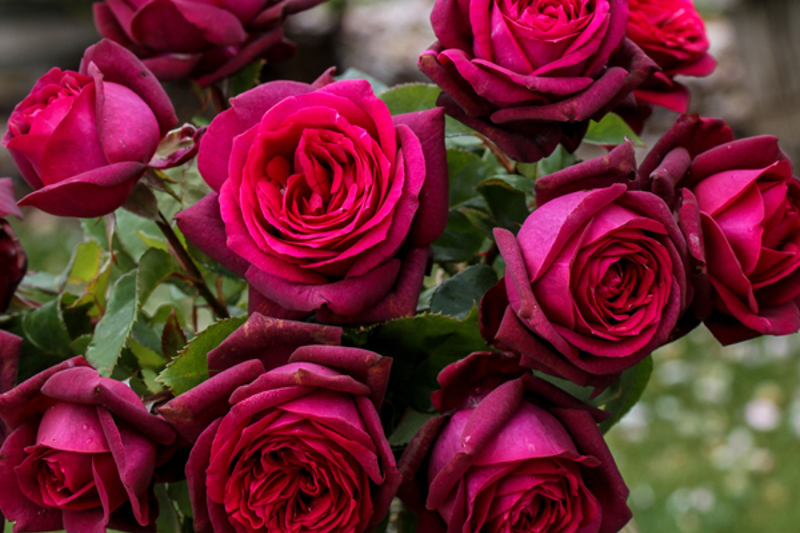
Hybrid Tea Rose 'Dark Desire'
Subcategories of Roses
The three main groups can be further subdivided into overlapping groups that describe important physical characteristics of each rose. By assigning a particular rose into all of these subgroups, you’ll be able to accurately predict its garden behaviour and care requirements.
The first subgroup categorises roses by their growth habit:
-
Bush Roses
Compact in size, usually between 0.8m and 1.2m high, with rigid, woody stems that need pruning each winter to force an abundant show of blooms.
-
Shrub Roses
Shrub Roses grow larger, ranging from 0.5m to 6m in height, spreading up to 5m wide. They're extremely varied in habit, leaf shape and flower form. They don't need a lot of pruning.
-
Climbing Roses
These roses will climb vertically when they have a structure or wall to support them, commonly reaching 3m or more in height.
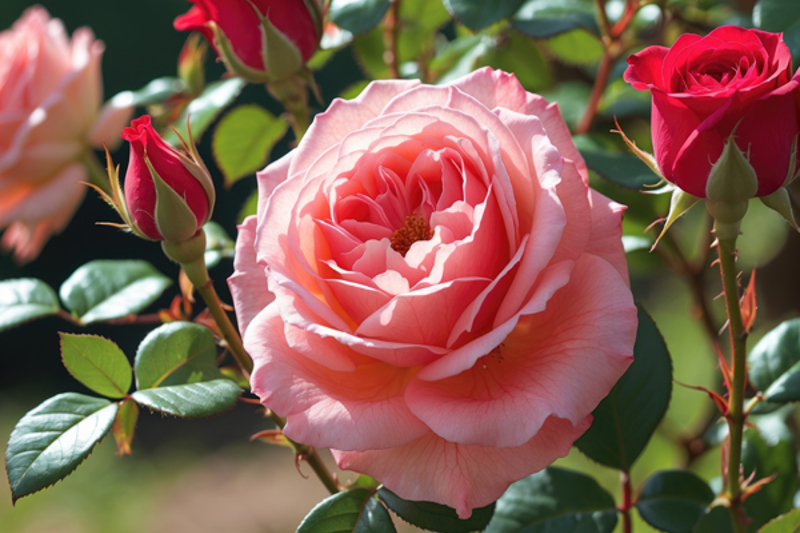
Climbing Floribunda Rose 'Dublin Bay', bred by Sam McGredy
The second subgroup splits roses by how often they flower:
-
Repeat flowering
(aka ‘remontant’) roses have a second flush of flowers.
-
Once-flowering
(these roses flower only once per season).
The third subgroup divides roses by flower structure:
-
Large flowered
(flowers form on single stems).
-
Cluster flowered
(flowers form in clusters).
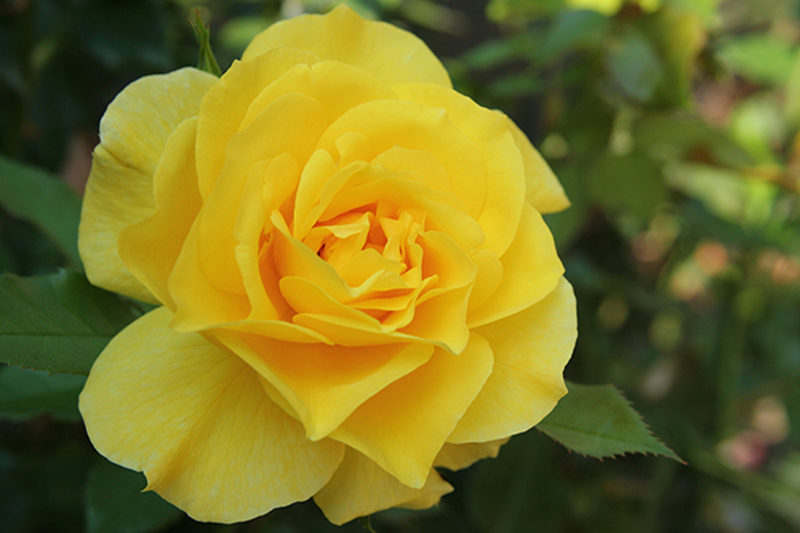
Floribunda Rose 'Friesia'
Roses are diverse, so there are lots of exceptions where a rose could fit into multiple categories. And because rose-lovers are equally diverse, there are different methods to make sense of the rose family!
This guideline is old-school, but serves as a useful shortcut so you know what to expect from a rose…so you can decide if there’s a place for it in your garden.
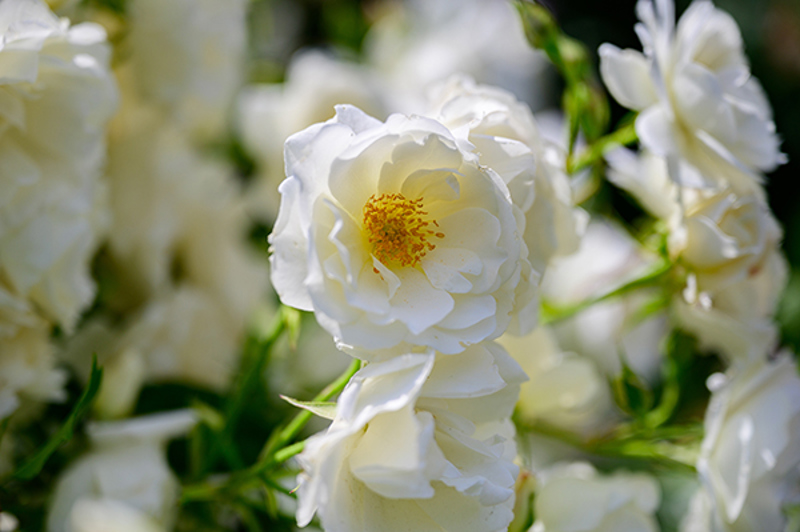
Rosa 'KORbin' is the International Name for the much-loved white Floribunda 'Iceberg', bred in 1958 by Kordes.
International Rose Names
When you're shopping for roses, you'll probably notice odd-looking abbreviations alongside the rose names, like 'MEIviolin' or 'KORbin'. These are examples of 'International Names' which register and identify a rose cultivar, worldwide. Often the first few letters will indicate the original breeder.
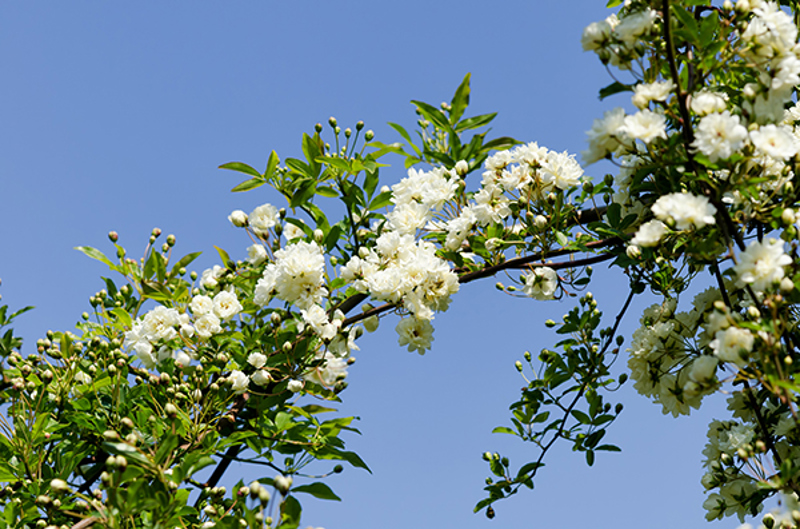
White Lady Banks Rose (Rosa banksiae var. banksiae)
1. Species Roses - Overview
Species or 'Wild' Roses are varieties grown in their ancestral, wild form. They're once-flowering, generally producing single, fine-petalled flowers (mainly in spring or early summer). Blooms are followed by a display of decorative berry-like hips in autumn. Most are large and thorny, with a climbing, scrambling habit, so they need plenty of space. Species Roses are vigorous, particularly resistant to pests and diseases and don't need much pruning, apart from removing straggly growth.
There are lots of different species in this class and sadly we don't have space to cover them all. Scabrosa (Rosa rugosa scabrosa), Climbing Prairie Rose (Rosa setigera), and the prickly Cherokee Rose (Rosa laevigata) remain popular garden choices in their original form.
Notable examples are the Musk Rose (Rosa moschata) and Multiflora Rose (Rosa multiflora), as many modern hybrids are descended from them.
Varieties of Banksia Roses (Rosa banksiae) are also a perennially popular choice, although they're unusual among Species Roses due to their pretty double flowers and lack of thorns.
Unfortunately, the very pretty Sweet Brier (aka Briar Rose, Rosa rubiginosa), Dog Rose (Rosa canina) and Field Rose (Rosa arvensis) quickly escaped from gardens after being introduced here during the 19th Century. They're now problem weeds in South Island tussock-lands, so keep a close eye on them if you have them in your garden.
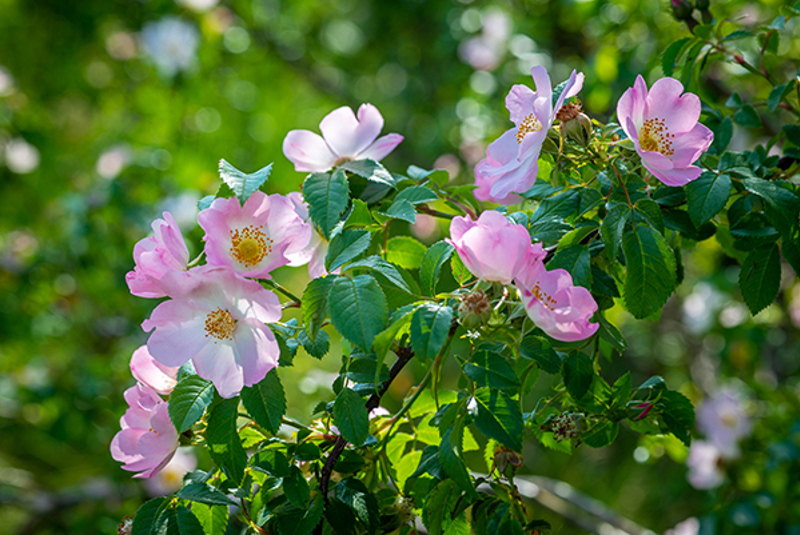
The Dog Rose (Rosa canina), introduced throughout Europe during the Roman Empire
2. Old Garden Roses - Overview
'Old Garden' Roses include a very broad group of rose species. Strictly speaking, to qualify in this category a variety needs to date from before 1867. However, to complicate things, lots of modern variants of the old cultivars are available. Old Garden Roses have made a comeback with discerning gardeners, due to their reliable garden qualities. The upsurge in interest makes sense, because they're particularly fragrant and hardy, with a delightful, informal character.
This group of roses are intricately intertwined: they were all being crossbred with one another for centuries before 1867. In fact, some of these roses were favourites in ancient Greece, appearing in botanical texts by Theophrastus and the poetry of Sappho. The infamous Roman Emperor Nero was a big spender on roses, shipped from rose nurseries around Paestum (near the Amalfi Coast in Italy).
The meaning of the designation ‘Heritage Roses’ is roughly similar to Old Garden Roses, but it's a different method of classification to the one we are using; the term 'Heritage Rose' describes heirloom roses that were bred more than 75 years ago.
It's useful to divide Old Garden Roses by flowering habit - into a repeat/remontant group and a once-flowering group.
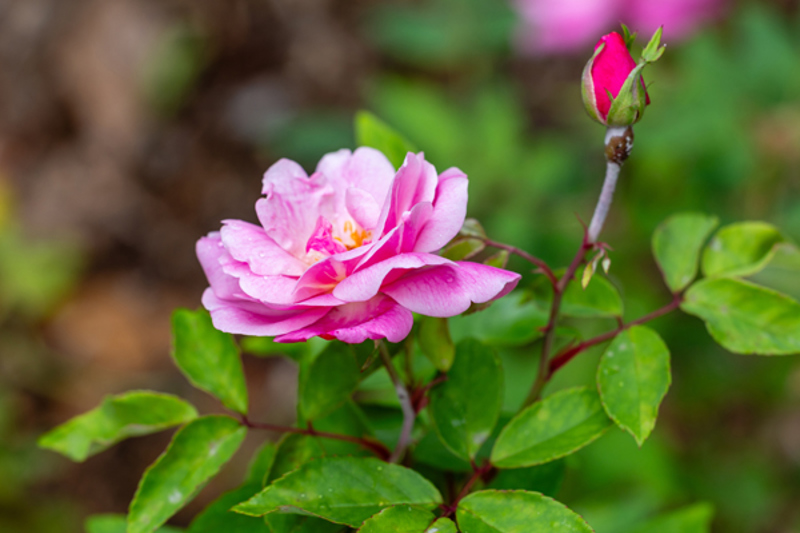
Pink China Rose 'Old Blush' (Rosa chinensis)
The repeat flowering (remontant) Old Garden group includes:
-
China Roses
Rosa chinensis originated in China as a wild rose, but this class is the result of centuries of breeding, in China and then Europe. They're quite variable in size, from knee-high to about 1.8m; they tend to be bushy and twiggy, with distinctively pointed, smooth leaves. Chinas have a very long flowering season. Blooms range from pink to crimson, petals darkening as they age. Scent is usually very muted. Did you know, all our modern deep-red coloured roses are descended from 'Slater's Crimson China', a variety that arrived in England in 1789?
-
Hybrid Chinas
Rosa x chinensis species include very old hybrids with obvious China rose parentage, like 'Cécile Brünner'.
-
Tea Roses
Rosa odorata got its English name because it smells like dried oolong tea. Tea Roses were originally bred by Chinese gardeners, then enthusiastically developed after their introduction to Europe. They have wider leaves than China Roses, but their growth habit and woody stems resemble their modern Hybrid Tea descendants. Flowers are slimmer than Hybrid Teas, but they share the same petal shape and silky texture; Tea Roses are the prototype for the elegant show roses we see today. Blooms come in delicate colours ranging from white to soft pink, coral to pastel yellow. Unlike China Roses, their flower petals fade lighter as they age.
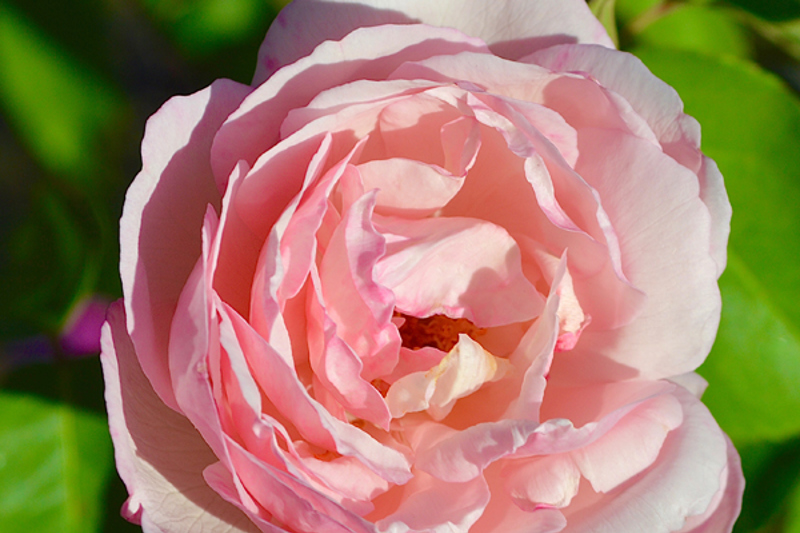
Tea Rose 'Duchesse de Brabant' (Rosa odorata)
Repeat flowering (remontant) Old Garden group, continued:
-
Bourbon Roses
Old hybrids of China and Damask Roses, from the island of Réunion in the Indian Ocean. Bushes are elegant-looking, with a similar size variation to China Roses, although some Bourbons are classed as climbers. Bourbon flowers inherited the open-faced shape and rich scent of a Damask, with the repeat flowering habit and smooth leaves of a China Rose.
-
Noisette Roses
Rosa noisettiana are hybrids of Musk Roses, Chinas and Tea Roses. All Noisettes are climbers, with a graceful-looking habit. Flowers are sweetly scented and come in a range of subdued colours from soft pink, to white, to pastel yellow. They offer good disease-resistance.
-
Hybrid Perpetual Roses
This type were at their peak of popularity during the Victorian era. Descended from Damask, Bourbon, and China Roses, they're quite variable in habit, ranging from compact bushes to sprawling, leggy semi-climbers. They share a tendency to produce huge, generous blooms; many are fragrant. They have a shorter flowering period than you'd expect from their name! Typically, they're greedy, high-maintenance and can be prone to mildew.
-
Portland Roses
A subtype of Hybrid Perpetuals (they're a cross between Gallica and Damask Roses). Their flowers resemble a Gallica in shape, but they're larger.
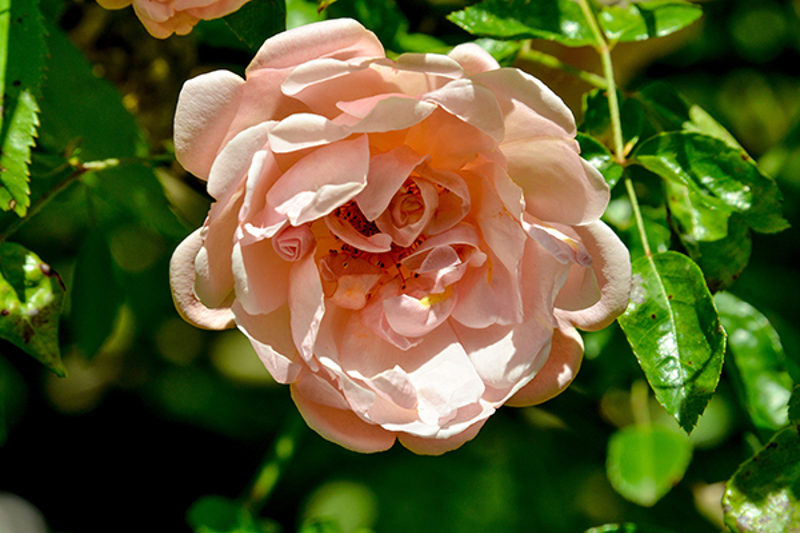
Bourbon Rose 'Souvenir de Malmaison'
Once-flowering Old Garden Rose types include:
-
Gallica Roses
Rosa gallica aka 'French Rose' or 'Rose of Provins', were favourites of the ancient Romans. Typically they reach 1m-1.5m in height, flowering abundantly in spring. Their flat-faced, ruffled flowers can range from pink to deep crimson, with white eyes and bright yellow stamens, and are often variegated.
-
Damask Roses
Rosa damascena were highly valued in the medieval Muslim Seljuk Empire, which led to their introduction into Europe during the Crusades. They're renowned for their intense scent. Historically, Damask Roses are the main source for Attar of Roses, a traditional ingredient in eau-de-cologne. Flowers are large, double or semi-double cup-shaped rosettes. Colour ranges from white to mid-pink. Damasks grow taller than Gallicas. Some will flower in spring and autumn, but most of the popular varieties only flower in spring.
-
Alba Roses
Rosa Alba grow quite tall (2-2.5m), needing very little pruning. They have white to pale pink, elegant flowers, a little bit like a Gallica in shape. The 'White Rose of York' from the medieval Wars of the Roses is an Alba (Rosa 'Alba Semiplena'). The opposing 'Red Rose of Lancaster' is a Gallica (R. gallica 'Officinalis')
-
Centifolia Roses
Rosa centifolia aka 'Cabbage Roses', date from the 16th Century. They were named for their big, globe-shaped, slightly tousled-looking blooms. Very old varieties are pink, but Victorian-era breeders developed white and violet versions, all with a heavenly scent. Centifolias must be propagated from cuttings, or grafted. They have a floppy growth habit, so they'll benefit from a stake to hold them up.
-
Moss Roses
Rosa × centifolia 'Muscosa' is another Victorian favourite, that has distinctive furry-looking 'moss' on its buds and sepals, sticky with pine-scented resinous oils. Moss Roses flower in spring. Most flowers are white to lilac.
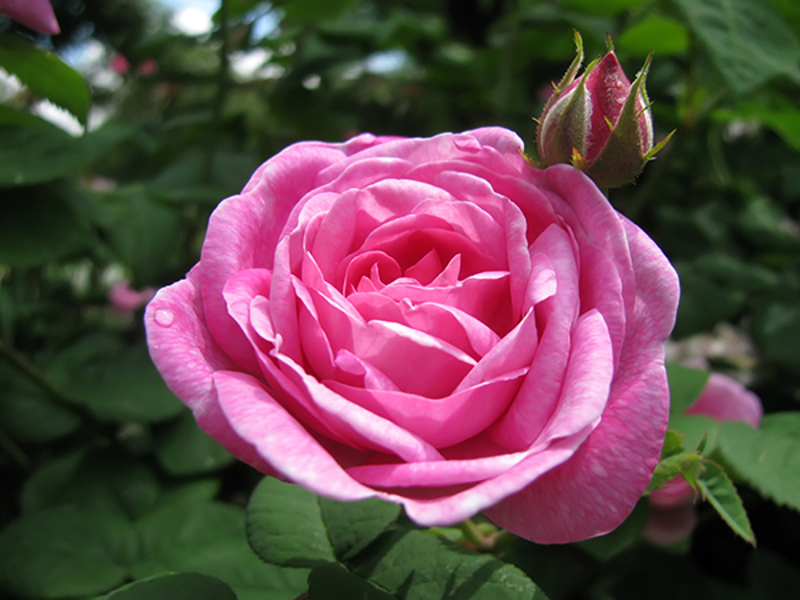
Damask Rose (Rosa damascena)
Pruning Old Garden Roses
It's best to prune Old Garden Roses very lightly. Remove dead wood each year in winter, but when you shorten the stems back to a strong bud, make certain you don't cut them back by more than 1/4 at a time. When in doubt, you can get away with skipping the winter prune for a year and simply deadheading the spent flowers.
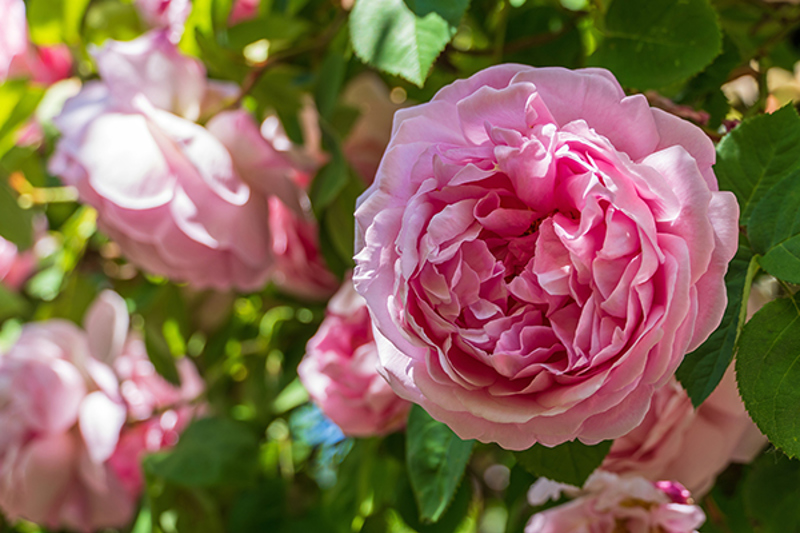
This enduringly popular modern shrub rose, 'Constance Spry' was breeder David Austin's first cultivar.
2(b). Modern Shrub Roses
This is an 'in-between' sort of category; so we've tacked it on to the Old Garden Roses section, although these are all technically Modern Roses. 'Shrub Rose' is often used as a general term to describe 'Old-Garden-lookalike' modern hybrids. These hybrids are crosses between old garden and species roses, floribundas and other modern types; they tend to have the tall, spreading growth habit of an Old Garden shrub rose, but they also have Modern benefits bred into them. This group is extremely varied in growth habit, size, leaf shape and flower form. Some of these roses can grow larger in NZ than in their country of origin, but your rose grower can advise what to expect.
This group don't need much pruning, other than getting rid of spindly or weak growth. The group includes:
-
Rugosa Hybrid Roses
Originating in Japan from the wild Rosa rugosa, these hybrids are famously disease-resistant, cold-hardy, unfussy about soil and rugged enough to tolerate coastal planting. They produce large, fragrant flowers. A popular choice for harvesting rosehips, for jam and preserves.
-
David Austin Roses
Bred to combine the gorgeous scents and graceful shape of Old Garden Roses with the fabulous colours and repeat flowering habit of modern hybrids. Vigorous growers, that need plenty of space. Renowned for their large, fancy cupped blooms.
-
Hybrid Musk Roses
Descended from the Musk Rose (Rosa moschata) they're fabulously scented, with a wide and tall arching habit, and generous clusters of floribunda-like flowers.
-
Groundcover Roses
Low-growing plants that spread out over a wide area. Hardy, vigorous, abundant flowers. Ideal for massed planting, to grow on banks, or small gardens. Very little pruning is required.
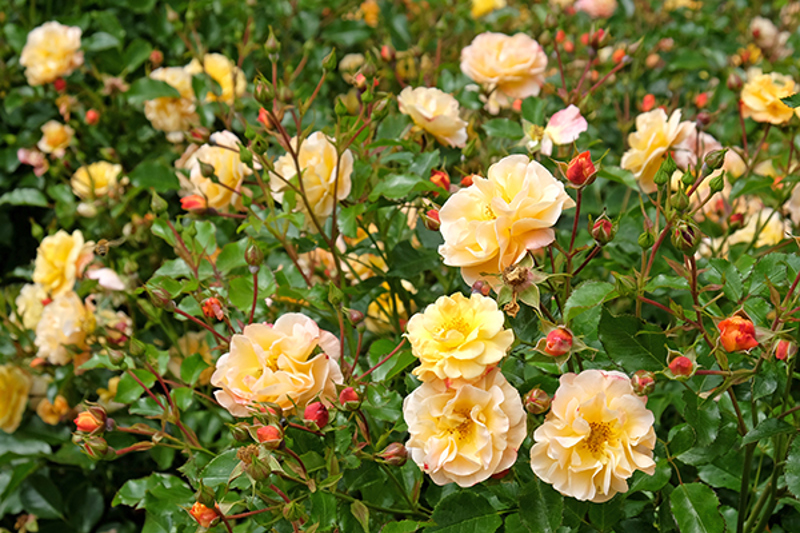
Groundcover Rose 'Flower Carpet Amber'
3. Modern Roses - Overview
This very broad group includes Hybrid Tea Roses, Floribundas, Grandifloras, Miniature Roses and Climbing Roses. We'll step through these in turn, as these are the roses you'll see most often in NZ gardens.
We can thank Napoleon Bonaparte's famous Empress Joséphine, for the special place roses have in our modern gardens. Joséphine was serious about gardening. The prominent botanists and horticulturists she kept on her payroll sparked her interest in roses, which led to her becoming an avid rose fan and collector. She wasn't shy about spending on beautiful things, so she created (possibly the earliest) formal rose garden at the Château de Malmaison near Paris. Joséphine hosted the first ever rose exhibition there, which helped put roses in the public eye and made them fashionable throughout Europe.
The story gets even better! During the Napoleonic Wars, Britain blockaded French ports as part of a bitter trade war. Although no trade goods were allowed through by the Royal Navy, the Prince Regent (soon to become King George IV) issued special permission for Joséphine's precious 'Hume's Blush Tea-Scented China' specimens to be safely delivered from Britain.
So, the scene was set for the explosion of creative rose breeding that happened in the Victorian era. By 1867, the rose-loving world was absolutely ready for the arrival of Modern Roses. The new hybrids quickly took over rose gardens: some of them have remained constant favourites, but gorgeous newly-bred roses keep on coming.
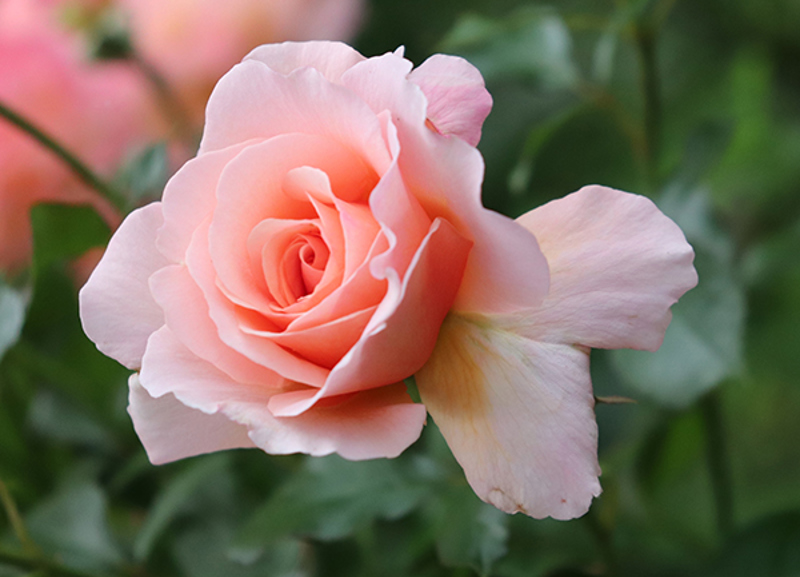
An 'Augusta Luise' Hybrid Tea Rose.
Hybrid Tea Roses
The most widely grown form of rose, modern Hybrid Teas are the results of more than a century of breeding for delicate colour and fragrance. They produce large, well formed solo flowers in a wide range of colours on long, upright stems. They make a good garden display, but this type of rose is all about admiring the perfect individual blooms. These are the best roses for cutting: they're absolutely beautiful showcased in a vase. Scent is variable; a lot of Hybrid Teas have no fragrance, but there are plenty of scented varieties available.
Hybrid Teas are always grafted onto strong rootstock and grow to about 1.5m in height.
Newly-planted Hybrid Teas are pruned to train them into an open 'cup' shape of woody stems. Each year during winter dormancy, bushes are pruned, first removing dead wood. Assess the oldest remaining stems: if there are any that have rough-looking bark and skinny stems, prune those off as well. The live stems that are left will be 1-3 years old. These live stems are shortened back to a strong bud - these buds will sprout new lateral stems, that deliver the spring blooms.
Pro Tip: Traditionally Hybrid Teas were pruned quite hard, but shortening lateral stems by half their length is generally enough - taking off 1/3 of the length is also common practise.
After you've cut the spring blooms to enjoy in a vase, new sub-lateral stems will develop below the cut, to produce a second flush of flowers. Repeat blooming roses like these are known as 'remontant' roses.
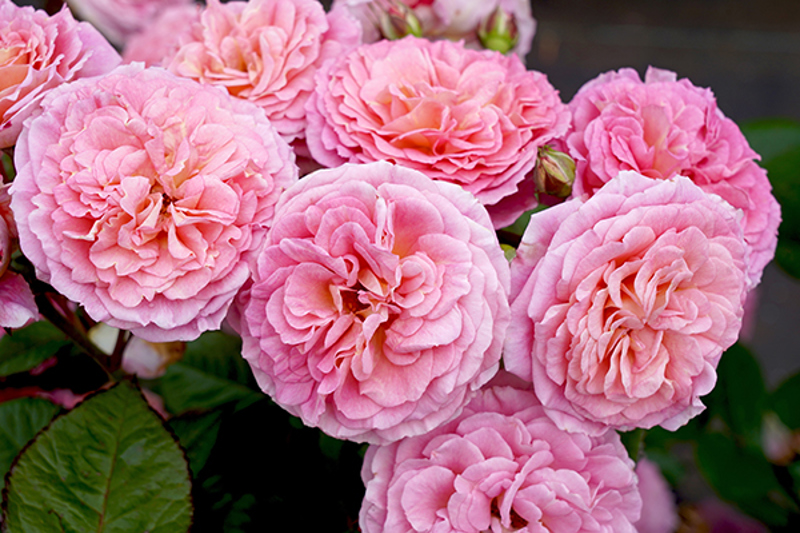
Floribunda 'Love Affair'
Floribunda Roses
Floribunda roses bear abundant clusters of small blooms, in a wide variety of colours. The flowery trusses of Floribundas aren't as practical for cut flowers as hybrid teas, but they provide a much more lavish display in the garden, over a longer period. A lot of Floribundas have no scent, but highly fragrant varieties are available.
Usually grafted onto rootstock, they're generally hardier than hybrid teas and only reach about 90cm in height.
Like Hybrid Tea roses, Floribundas bear flowers on one-year-old stems, so new growth is best pruned lightly. Don't be shy with the old woody growth though, prune it hard during winter. The remaining live stems are pruned back to a strong bud - these buds will sprout new lateral stems, that deliver the spring blooms.
Pro Tip: Make sure you never shorten stems to more than 1/2 of their length; taking off 1/3 is pretty standard.
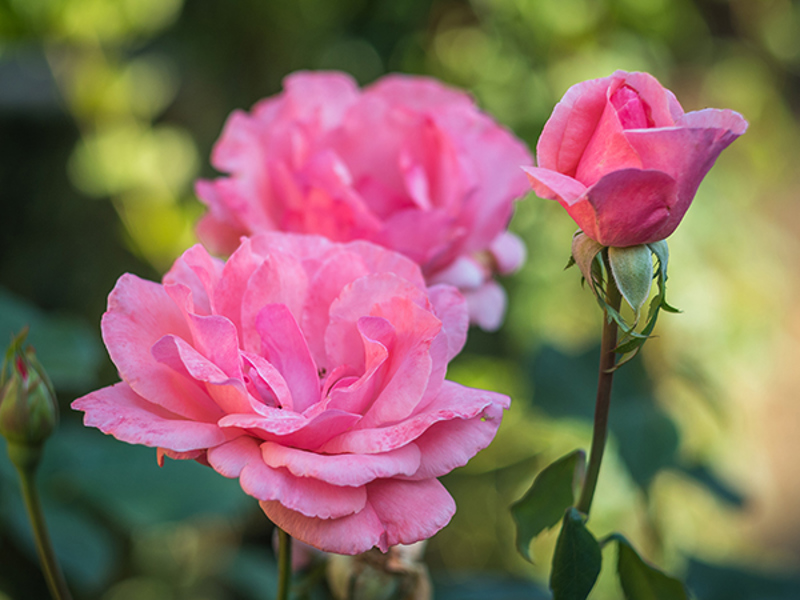
Grandiflora (Floribunda) 'Queen Elizabeth'
Grandiflora Roses
A cross between Hybrid Tea Roses and Floribundas, that combines the most attractive qualities of both. You'll mostly see this type mentioned in websites or books from the USA, as European growers traditionally assign these 'intermediate' roses as either a Hybrid Tea or a Floribunda. For example, the classic 'Queen Elizabeth' (pictured) is a Grandiflora in the USA, but considered a Floribunda in Europe.
The flowers look like slightly smaller Hybrid Tea blooms on tall stems...but the abundant clusters of flowers and continuous blooming are just like a Floribunda. They grow quite tall (up to 1.8m) so they make a striking statement in a garden. Usually they aren't very fragrant, but the gorgeous floral display more than makes up for it.
For pruning, treat Grandiflora roses just like Hybrid Tea varieties.
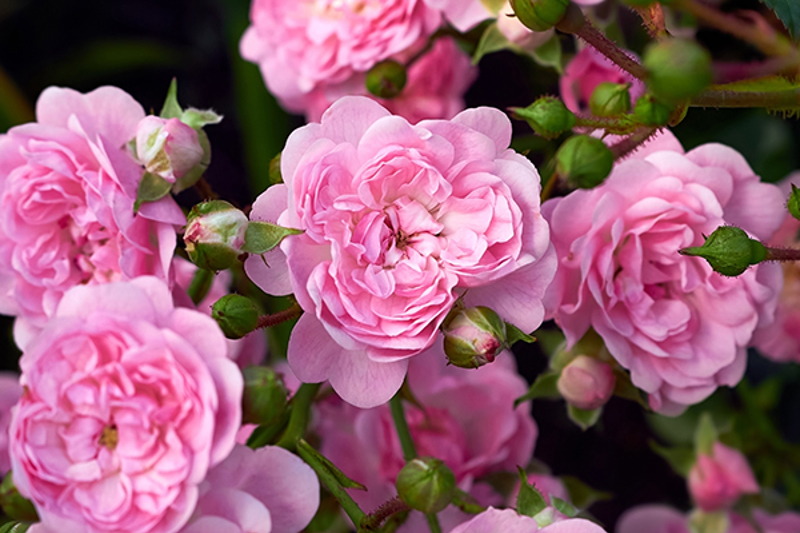
Polyantha 'The Fairy' rose
Polyantha Roses
An old-fashioned Hybrid Tea cross, Polyanthas aren't widely grown but deserve to be, because of their hardiness! Their abundant clusters of small blooms can be single, semidouble or double in form and generally produce a more subtle display than floribunda types. A relatively low height makes them an excellent choice for mass planting.
Prune lightly in winter. Aim to reduce twiggy growth and maintain a nice shape, then shorten live stems back to a strong bud. Shorten stems by no more than 1/3.
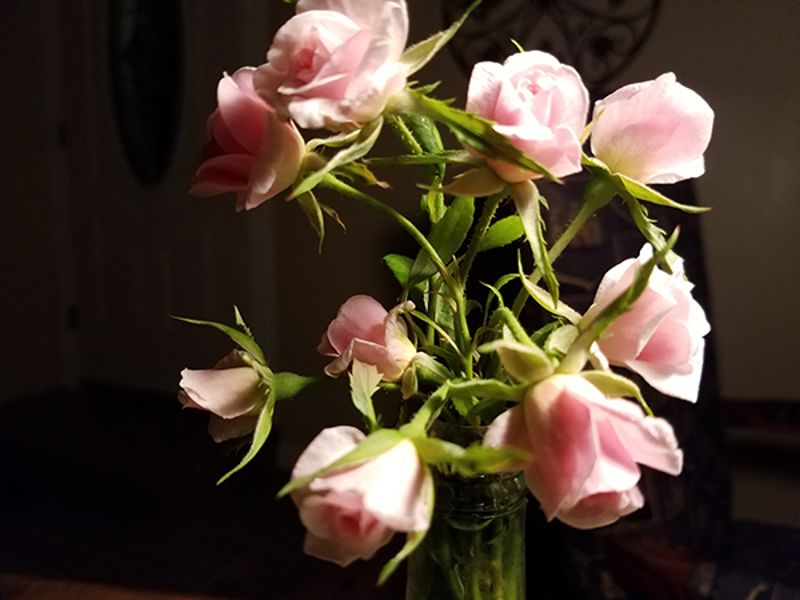
A Miniature Hybrid China 'Cécile Brünner' rose.
Miniature Roses
Miniature roses are tiny Floribundas or Hybrid Teas, with little leaves and wee flowers in perfect proportion. They normally grow between 20–50cm high and are almost thornless. They can be used for edging, growing in containers, rockeries, window boxes or indoors as temporary houseplants. These little beauties aren't grafted.
They only need minimal pruning, to maintain a nice shape. Cut out deadwood, then shorten live stems back to a strong bud - these buds will sprout new lateral stems, that deliver the spring blooms. Pro Tip: Make sure you never shorten stems by more than 1/3. Remove spent flowers as needed.
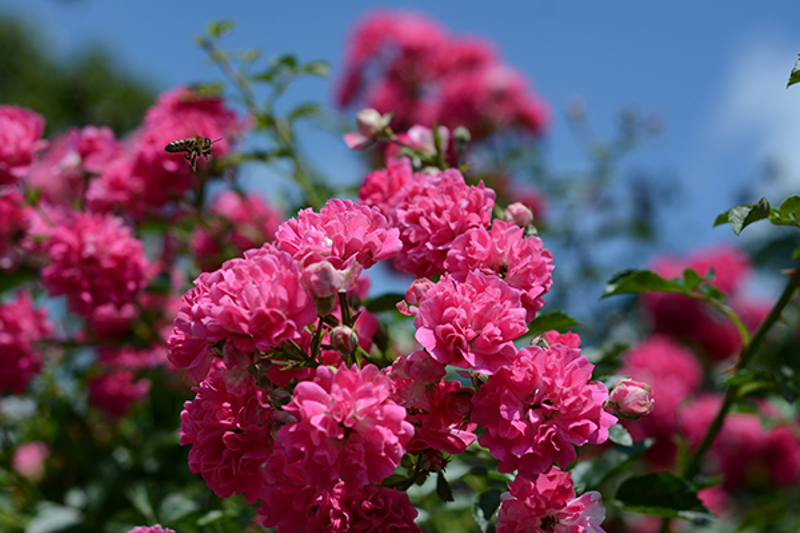
Rambling rose 'Dorothy Perkins'
Climbing Roses
This is a large and diverse group, with a vast range of beautiful roses to choose from. Rambling Roses and Climbers are included in this group because they both climb when they have a structure or wall to support them. However, we'll consider them separately, because they're distinct rose types, that have very different care requirements.
(a) Rambling Roses
Ramblers are covered with a stunning display of petite flowers when they bloom in spring. They're vigorous growers, with long, pliable canes that bear large tumbling trusses of smallish flowers. They produce several of these strong, flexible stems from their base each year, which you can tie into place to scramble up a trellis, pergola or wall. Alternatively, they're well-suited to an informal garden where they can sprawl on neighbouring shrubs or trees; they can spread out to 4-6m.
The canes of Ramblers only flower once. Each year, they need to be pruned right back to the ground straight after flowering, so new flowering stems can grow up again next season. Because Ramblers need to be re-trained every year, if you prefer the formal look they demand a bit more work than most rose types, but you don't need to train them if you plant them amongst shrubs that can hold them up in a big flowery mass.
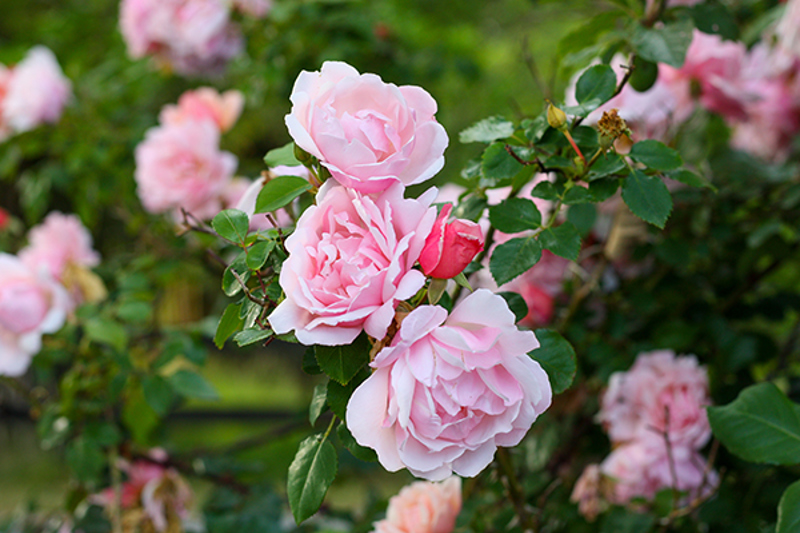
Rambling rose 'Albertine'
(b) Climbers
Climbers grow stout, rigid stems and their height potential is far greater than Ramblers - growing up to 6m tall and spreading 3-4m. They generally need to be secured to the support structure they're leaning on. Although they're quite hardy, Climbers are usually less vigorous than Ramblers. Generally, Climbers are repeat flowering, with larger flowers than Ramblers. Climbers are deservedly popular for their fragrance; flowers range from gorgeous massed clusters to single, large blooms.
A common reason to choose Climbing Roses over Ramblers is that most Climbers will bloom twice a year. These 'remontant' Climbers are pruned during winter dormancy, a little harder than most rose types. Thin out dead wood, then shorten the live lateral stems, only retaining 3 buds on each. Once established, Climbers don't shoot many new canes from the base, so be cautious about cutting canes right back to the ground. Look for lateral stems emerging from higher up the canes to give you the growth you're after.
It's best to plan ahead and check the full-grown height of a Climber, to make certain it won't grow too big for your space (otherwise you'll need to constantly prune to keep it under control).
Pro Tip: Once-flowering Climbers don't respond well to severe pruning, so for those just take out the dead canes, no stem shortening is needed.
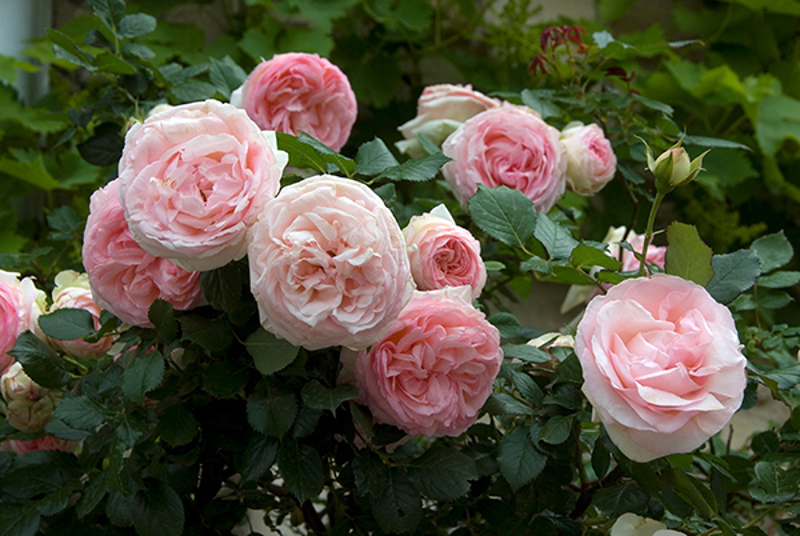
Climbing rose 'Pierre de Ronsard'
Did You Know?
The 'Winter Rose' or Hellebore isn't related to the rose family at all. In fact, they're members of Ranunculaceae, the buttercup family. Find out more about Hellebores here.



















Share
Share this article on social media